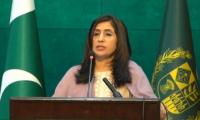Islamabad : While major improvements are visible in the domains of child survival and maternal health care, progress has relatively been slower in nutrition and family planning use among women. Although stunting has declined since 2012-13 when 45% of children under 5 were stunted, still 38% of children in Pakistan are too short for their age. Women in Pakistan are more overweight or obese than ever before—52% of women aged 15-49 in 2017-18 as compared to 40% in 2012-13. The country also has one of the highest fertility rates in the region with an average of 3.6 births per woman. The use of family planning among married women has stagnated around 34% over the last five years. The unmet need for contraception remains high at 17%.
These data are enshrined in the Pakistan Demographic and Health Survey (PDHS) 2017-18, which was released here Friday with the combined efforts of the National Institute for Population Studies (NIPS) under the aegis of the Ministry of National Health Services.
This is the fourth PDHS survey conducted in Pakistan since 1990-91, and the first to include information on disability. According to the report, 9% of women and 7% of men aged 15 and above have difficulty or cannot function in at least one domain of disability—seeing, hearing, communicating, remembering or concentrating, walking or climbing steps, and washing all over or dressing.
The survey informs that more children in Pakistan are surviving early childhood than ever before. Under-5 child mortality has declined from 89 deaths per 1,000 live births in 2012-13 to 74 deaths per 1,000 live births. Moreover, basic vaccination coverage has also improved as 2 in 3 children aged 12-23 months have received all eight basic vaccinations—an increase from more than half of children in 2012-13. Basic vaccination coverage is lowest in Balochistan (29%) and highest in Punjab (80%).
Reproductive health care coverage in Pakistan is also improving. Nearly 9 in 10 women age 15-49 receive antenatal care from a skilled provider such as a doctor, nurse, midwife, or lady health visitor. Additionally, more than half of women have their first antenatal care visit in the first trimester, as recommended. Half of women make four or more antenatal care visits, a notable increase from 37% in 2012-13. More births are delivered in a health facility, from 48% in 2012-13 to 66% in 2017-18. Yet, 1 in 3 births are delivered at home. Generally, families in Pakistan are getting healthier, the survey states.
On another note, the survey informs that 1 in 9 persons in Pakistan have moved to their current place of residence from another place. Fourteen percent of households had at least one out-migrating member. The most common reasons for out-migration are better economic opportunity and marriage.
According to the survey, more than 1 in 4 ever-married women (28%) have experienced physical violence since age 15, and 6% have experienced sexual violence. Seven percent of women who have ever been pregnant have experienced violence during pregnancy. Three in ten women who have ever experienced physical or sexual violence sought help to stop the violence, yet 56% never sought help nor told anyone.
Speaking on the occasion, Parliamentary Secretary for Health Nosheen Hamid expressed how much more work has to be done on child and maternal health programmes to make them more result-oriented. She welcomed population surveyors, students, NGOs and other relevant departments to come forward and analyze the PDHS data so that better health initiatives can be developed and implemented.
USAID Deputy Mission Director Helen Pataki noted that the PDHS is not just a report card on the last five years; it also directs our efforts for the next five. “Together, we can review what has worked well and where further support could make a difference to improve basic health care and end preventable deaths.”
Dr. Ruth Lawson, Head of Basic Services at the UK’s Department for International Development (DFID) stated, “The UK is proud to have partnered for the survey, as good data leads to evidence-based decision making. I’m glad that this survey reports on disability as well, as DFID’s programmes are especially focused on leaving no-one-behind.”
UNFPA Representative Lina Mousa said commended the strategic partnership of UNFPA with NIPS and Pakistan Bureau of Statistics on strengthening the national data system. “Population censuses and PDHS surveys are crucial to the development of national strategies as well as localization of the SDGs.”
The 2017-18 PDHS was implemented by NIPS under the aegis of the Ministry of National Health Services, Regulations, and Coordination, Islamabad, Pakistan.
Representational file. — APP FileRawalpindi:A speedy bus overturned after hitting an electric pole resulting in...
Political Counsellor of Great Britain in Pakistan, Zoe Ware called on Federal Minister for Privatisation, Board of...
The delegation, accompanied by senior officials from the British Council and the Higher Education Commission of...
Inspector General of Police Islamabad, Syed Ali Nasir Rizvi. — Radio PakistanIslamabad: In light of the special...
National Commission for Human Rights logo. — Facebook/National Commission for Human RightsIslamabad: The National...







